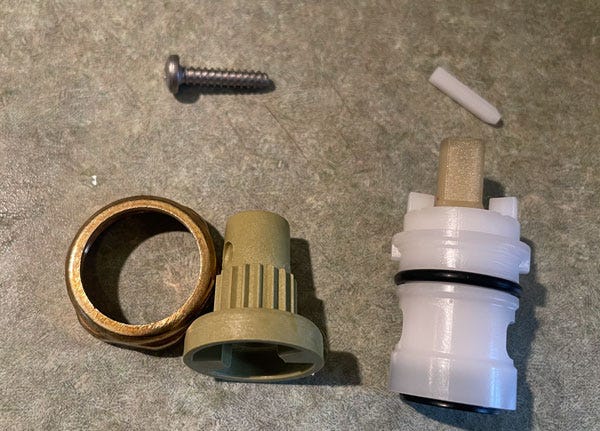Welcome to another edition of Willoughby Hills!
This newsletter explores topics like history, culture, work, urbanism, transportation, travel, agriculture, self-sufficiency, and more.
If you enjoy what you’re reading, please consider a free subscribtion to receive emails every Wednesday and Sunday plus podcast episodes every two weeks. There are also paid options, which unlock even more features.
I did a small renovation in my kitchen around 2009, updating the countertops, the sink, and the faucet. I bought a simple faucet at Home Depot made by American Standard that was around $100 if I recall correctly (When I Google it, Bed Bath and Beyond has the same unit listed for $79.99, although it’s no longer for sale. Also, Bed Bath and Beyond’s website is still operational despite all of its stores closing. It’s run by Overstock.com now.)
The faucet wasn’t the most expensive one on the market, but it was a step up from the utilitarian faucets that were under $50. It was advertised with lots of attributes that gave me some confidence that the faucet would be long-lasting:
Leakproof ceramic disc valves
Maintenance-free, no rubber washers
Durable solid brass construction
At the time, I was a producer with This Old House which made me more attentive to my choice in faucets than most, but honestly, I was just looking for something that could look halfway decent, didn’t cost much, and would be trouble free.
My new faucet delivered on all of those promises. At least for a while. At some point, maybe three or four years after I first installed it, the faucet began to drip.
I remembered that my American Standard faucet came with a lifetime warranty and I decided to call their customer service department to seek assistance. I didn’t expect much. I no longer had the receipt for my purchase, but had saved the install manual so I knew the model number.
I described the problem to the person on the phone and told the representative which faucet I had. Because of the lifetime warranty, they had no trouble sending me new parts for the faucet. It was quick and painless.
This exchange was more than a decade ago, so you may be wondering how I can recall it with such clarity. It’s because this phone call ended up being repeated again and again roughly every three years for years to come.
I would install the parts that American Standard sent, my faucet would work well for a few years, but at some point a few years later, drips began to appear again. So I’d call American Standard, have new parts shipped, and install those. Lather, rinse, repeat.
My faucet is a two handle design, meaning one handle controls hot water and another handle controls cold water. Under each handle is a faucet cartridge, which was the part that I kept replacing. Home Depot sells a single cartridge for around $15, so each time American Standard sent me a pair of replacements, I was receiving the equivalent of $30 in retail value.
Let’s say that I repaired the faucet three times over its lifetime. That means I was sent $90 in new parts for my faucet that only cost me $100 originally.
At some point, my faucet began to corrode and I couldn’t remove the cartridges anymore. I again called American Standard to describe this new problem, this time requesting an entirely new faucet because I didn’t think repair was possible.
I was told that my specific faucet was no longer being made, but that I could select a new similar faucet from their catalog. I was emailed a link to a website, along with some suggested replacements that might be similar in appearance and function to my old faucet.
I found one that met my criteria, although it was one that retailed for about $350. Again, I feel like it’s worth pointing out that I paid $100 for my original faucet and had already received about $90 in replacement parts over the years. I had my doubts that American Standard would send me a $350 faucet, but I was told it was no problem and a new $350 faucet arrived via UPS a few days later.
I wish I could say that installing a more expensive faucet solved the problem, but again, after a few years, a drip appeared again. So I called American Standard and had another round of parts shipped to me, this time for my new faucet.
At this point, I’m guessing I’ve received close to $500 in replacement parts from American Standard (including the replacement faucet). Or put another way, they’ve lost $400 to maintain me as a customer, since the only money they received from me was my initial $100 purchase.
I share this story for a few reasons.
First of all, just like I’ve discussed with dishwashers and refrigerators, I feel like a kitchen faucet should last a long, long time without ever needing to be serviced or replaced. My grandparents had a classic Delta ball faucet in their kitchen and I don't recall it ever needing anything.
But perhaps more importantly, I feel like my experience with faucets points to the madness of capitalism. My original faucet appears to have been manufactured in Mexico; it’s unclear where the replacement one was made.
I have no idea how they were manufactured, but like most products these day, I wouldn’t be surprised if every inch of the design of the faucet and the manufacturing process were scrutinized to save a few pennies. Plastic parts in place of brass, making parts slightly thinner to save money, cladding plastic parts with a metallic plating to give the appearance of metal without the cost.
Yet all of these savings were worthless in my case because the cheaper construction and materials of my faucet meant that I had to swap parts more frequently. Had American Standard spent a little more money to make a slightly better product, they wouldn’t have spent so much time, money, and effort sending me so many replacements.
I don’t mean to single out American Standard here, as Moen, Kohler, and nearly every other brand name plumbing fixture manufacturer follows the same playbook: manufacture cheaply and offer a lifetime warranty with free replacement parts. I’ve had to call their customer service lines to deal with warranty issues on other plumbing fixtures too.
The reason they all continue to do this rather than make slightly better products up front is because most people don’t bother to take advantage of the warranty. At the sign of the first drips, most people would spend another $100 for a new faucet. Or if they did opt to repair their existing faucet, they may have gone to Home Depot and bought replacement cartridges for $30. In theory at least, Home Depot shouldn’t need to stock any faucet parts as they are all available free from the manufacturer. In practice, they have an entire aisle filled with parts.
If I had to guess, the offering of a lifetime warranty has been found to be an enticing marketing phrase to convince consumers to make a purchase; a warranty that they will soon forget by the time parts begin to break.
I’m sure there’s also market research that suggests the balking point of consumers when it comes to faucet pricing. I happily paid $100 for my faucet because it felt like a good deal, but would I have been as willing to pay $125 or $150 for a better faucet? Maybe, but there’s also no guarantee that spending a little more means better build quality.
Even a faucet worth $350 didn’t immunize me against poor build quality or parts that wear down quickly.
So American Standard loses some money shipping me and folks like me a few parts every few years, but they make a lot, lot more by selling people full replacements because most people don't even realize faucets can be repaired by a handy DIYer and instead think a kitchen faucet should be replaced like a toothbrush.
Were an executive at American Standard to see my particular case history on a spreadsheet, I think they would be appalled: a $100 purchase more than a decade ago turns into $500 in merchandise.
Yet CEOs don’t look at individual customer experiences when making decisions. They look at all costs and revenues in aggregate. Manufacturing in Mexico is cheaper than manufacturing in New Jersey, plastic is cheaper than metal, etc., etc.
The person in marketing who plans a campaign around a “lifetime warranty” usually isn’t talking to the people in manufacturing who know that “lifetime” is very short given the way the items are made.
So as customers, we consume and consume, waste and waste. We waste money on buying new things every few years that should last much, much longer. We waste time going to the store, installing new faucets, or replacing parts on old ones. And we add waste to our landfills in the form of cheaply made parts or fixtures that are constantly being replaced.
But capitalism doesn’t care about the waste. Capitalism doesn’t care that we’re literally making life on this planet worse and worse every single day with our consumption. Capitalism only cares about the bottom line.
There are ways that I’ve been able to largely opt out of our industrial systems in small ways: eating real foods from local farms rather than processed garbage from big food companies. Buying second hand clothes or not buying clothes at all.
But when it comes to certain household items like faucets, appliances, carpet, and mechanical systems, I’m not sure what the alternative looks like. The only option I see is to use a time machine to go back a few decades to when things were a little higher quality.
Absent a DeLorean with flux capacitor, I suppose my only other option is to just keep calling to order more parts each time my faucet drips. In a broken system, repairing is at least better than replacing.
Thanks for reading Willoughby Hills! Subscribe for free to receive new posts and support my work.
Related Reading
Getting Acquainted with Wendell Berry
If you’ve missed past issues of this newsletter, they are available to read here.








